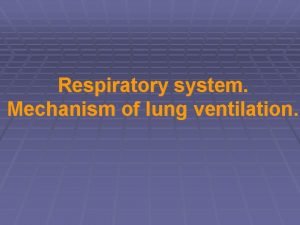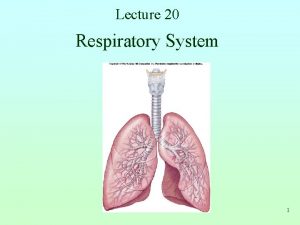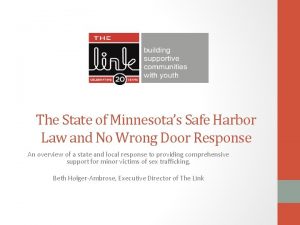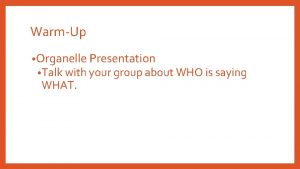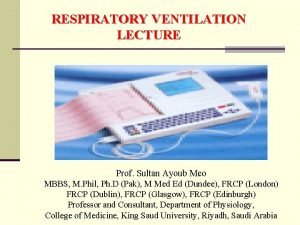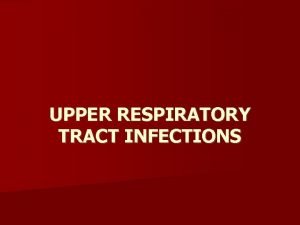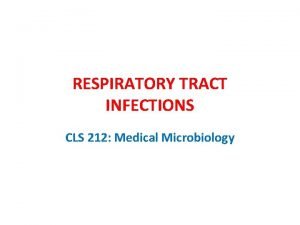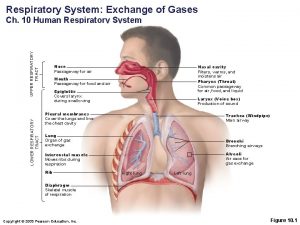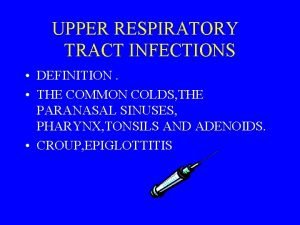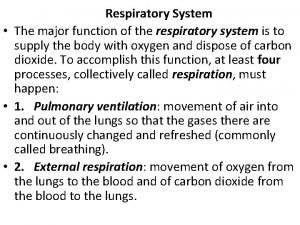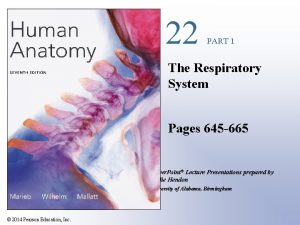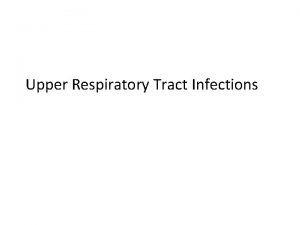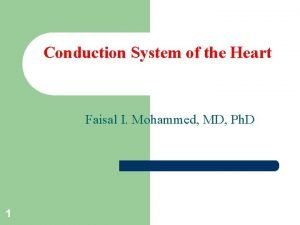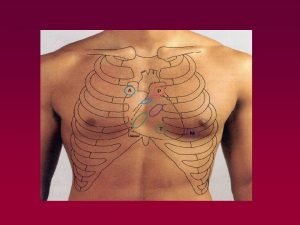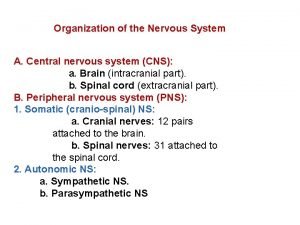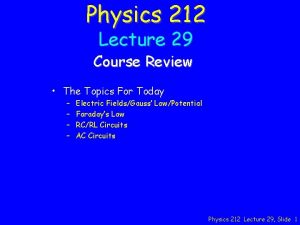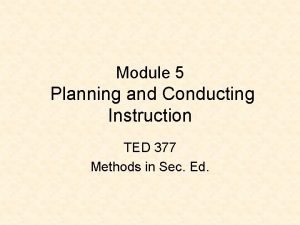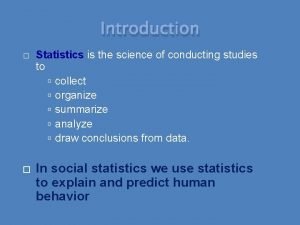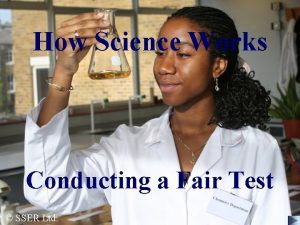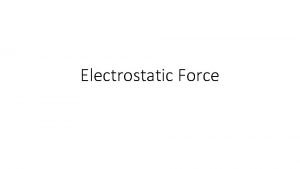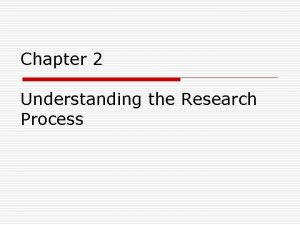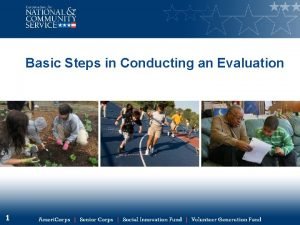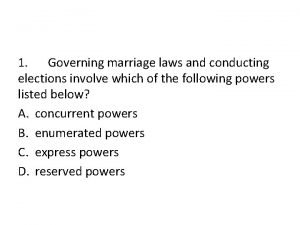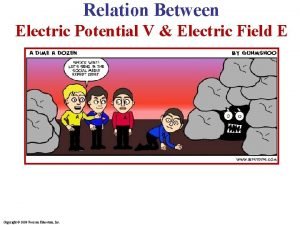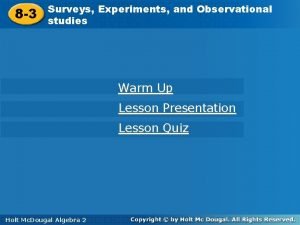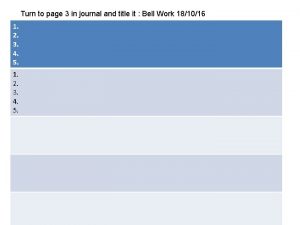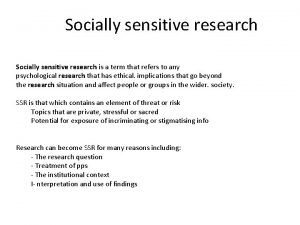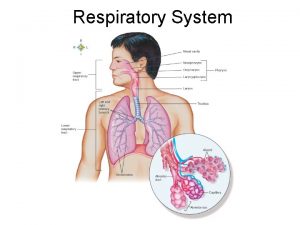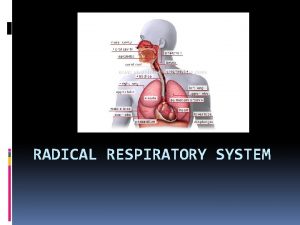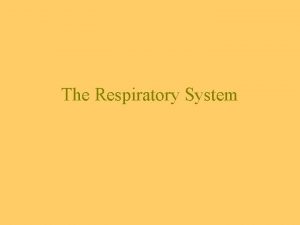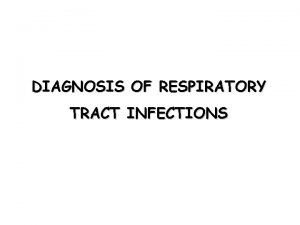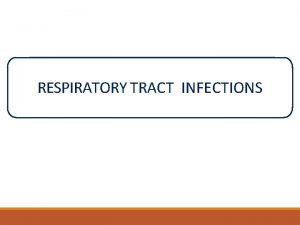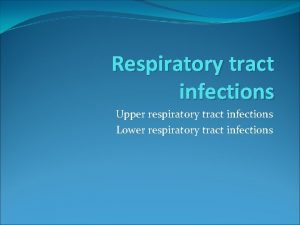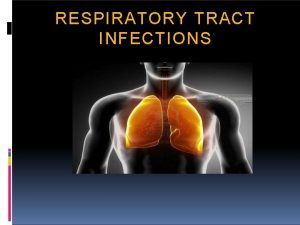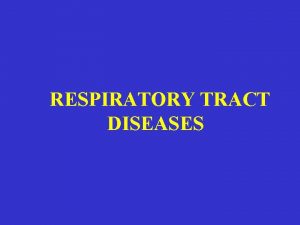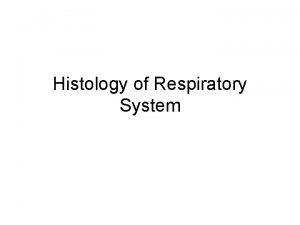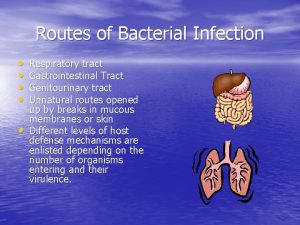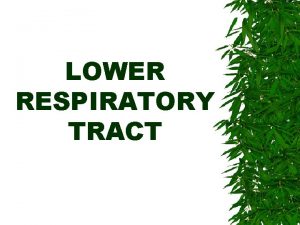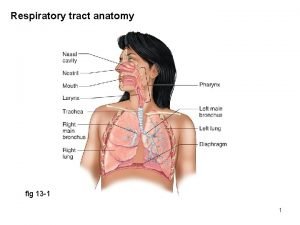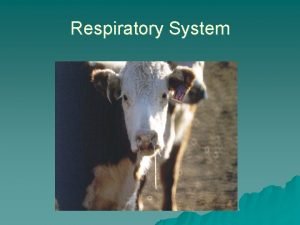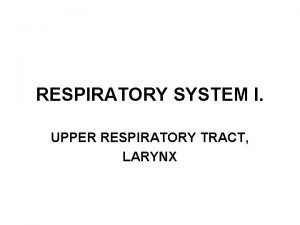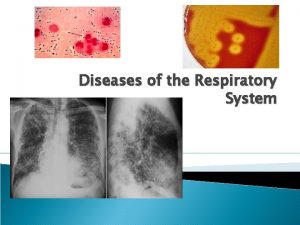The Respiratory System The Respiratory tract Conducting passageways












































- Slides: 44

The Respiratory System

The Respiratory tract • Conducting passageways carrying air to and from the alveoli – Upper respiratory passages filter and humidify incoming air – Lower passageways include delicate conduction passages and alveolar exchange surfaces

The Components of the Respiratory System

Respiratory Mucosa • This mucus protects delicate lower respiratory track by filtering out dust, dirt, and pathogens • This mucus is then removed from the body or sent to the stomach for the stomach acid to destroy pathogens


The Bronchi and Lobules of the Lung

The Respiratory System has two Major Responsibilities • Supply the blood (and ultimately the tissues) with O 2. • Remove CO 2 • Simply stated: Respiration involving breathing O 2 in and expelling CO 2. • However, it’s more complicated than that.

The Two types of respiration • Internal Respiration: within the cells, cellular respiration • External Respiration: involves movement of air and gasses

Internal Respiration • Internal respiration refers to the metabolic processes occurring using sugar and oxygen making energy in the mitochondria. • Molecular oxygen is used by tissue cells. • Carbon dioxide is produced

2 Types of Internal Respiration • Aerobic respiration – With Oxygen – C 6 H 12 O 6 + 6 O 2 6 CO 2 + 6 H 2 O + 36 or 38 ATP • Anaerobic respiration – Without Oxygen – C 6 H 12 O 6 2 CO 2 + 2 C 2 H 5 OH + 2 ATP

External Respiration • The sequence of events involved in the exchange of O 2 and CO 2 between the external environment and body’s cells. • It includes: – Breathing: air moved between the atmosphere and Lungs (alveoli). – Gasses exchanged between the lungs and the blood. – Movement of gasses between the lungs and the tissues.

There are four parts or steps in the Respiration Process • • • Pulmonary Ventilation Pulmonary Diffusion Blood/Gas Transport Gas/Tissue Exchange Actually only the first two are respiration. However, the second two are best considered here under the topic of respiration.

Each Step Has Two Parts or Halves. • The first half involves getting O 2 into the body. • The second half involves getting CO 2 out of the body.

1 st: Getting O 2 into the body • • O 2 from the atmosphere into lungs (alveoli). (Pulmonary Ventilation) O 2 from the alveoli into pulmonary capillaries. (Pulmonary Diffusion) O 2 from lungs (pulmonary capillaries) to the tissues (blood/gas transport) O 2 from blood into the tissues. (Blood/ gas tissue exchange)


2 nd: CO 2 out of the body (reverse order) • 4. CO 2 from the tissues to the blood. (blood/gas tissue exchange) • CO 2 from the tissues to the lungs (blood/gas transport) • 2. CO 2 from the pulmonary capillaries to the alveoli. (Pulmonary Diffusion) • CO 2 from the lungs (alveoli) to the atmosphere. (Pulmonary Ventilation)

The respiratory system carries out non-respiratory functions. • It provides a route for water loss and heat elimination. • It enhances venous return. • It contributes to the maintenance of normal acid-base balance. • It enables various kinds of vocalizations. • It defends against inhaled foreign matter. • It is part of the sense of smell.

The Respiratory System Consists of Three Parts • The Air Passages • The Lungs • The Breathing (Thoracic Muscles) – Intercostals muscles – muscles between your ribs, when they contract the rib cage opens and are only active during inspiration – Diaphragm – muscle that is attached to the bottom of your lungs, When it contracts it lowers and is only active during inspiration

Lobes of the Lungs

Airways conduct air between the atmosphere and alveoli. • Inhaled air passes through the following series of continuous airways in this sequence: 1. 2. 3. 4. 5. 6. Nasal passages Pharynx Larynx Trachea Bronchi (left and right) Bronchioles 7. Alveoli



Each Part has a Specific Purpose • The Nasal Passages & Mouth lead to the Pharynx (throat). • The Pharynx branches into two tubes. – One becomes the esophagus (for food to the stomach) – The other goes through the larynx to the trachea • The larynx (voice box) has vocal folds. – It has two strong elastic, connective bands which vibrate when air passes over them. – Along with the tongue, teeth and palate, speech is possible – The bands tighten up when swallowing to prevent passage of food into the trachea • The Trachea divides into two tubes

Esophagus and Trachea

Air Passages continue from the Trachea • At the base of the trachea, this respiratory tract spits into a right and left bronchus. • The walls of the trachea and bronchi are reinforced with rings of cartilage. (holds windpipe open) • The bronchi continue to split into smaller tubes, bronchioles. The cartilage is absent in the bronchioles. • The bronchioles are smooth muscle tubes, capable of changing the airflow through them by dilating and constricting. • At the end of each bronchiole is a cluster of air sacs called: Alveoli


The Bronchi and Lobules of the Lung

Alveoli • The Alveoli are the actual exchange sites of the gases. • Up to this point, the air passages simply provide a method to get air (O 2 & CO 2) into and out of the lungs. • No exchange of gasses has occurred.

Aveoli and 2 capillaries

The alveoli are thin-walled, singlecelled inflatable sacs. • Gas exchange is their function. They are encircled by pulmonary capillaries. • We have about 300 million alveoli. • The alveoli offer tremendous surface area for gas exchange by diffusion. • Equal to the size of a tennis court (75 -80 Sq. meters).

Alveolar Organization

The Lungs Occupy Much of the Thoracic Cavity. • The lungs are incased in a protective cage called the Thoracic Cavity. (Spinal column, ribs and sternum). • The lungs are attached at the bottom to a sheet of muscles called: the Diaphragm. • The diaphragm is a skeletal muscle for breathing. • It separates the thoracic and the abdominal cavities. • A pleural sac (membrane) separates each lung from the thoracic wall. • The pleural cavity is the inside of the pleural sac.


Breathing (Ventilation) includes two processes: • • Movement of air (gases) into and out of the lungs. Exchange of gases between the lungs (alveoli) and the blood (pulmonary capillaries).

There are different pressures inside and outside the lungs. • Atmospheric pressure is 760 mm of Hg at sea level. • Intra-alveolar pressure is the pressure in the alveoli. • Intrapleural pressure is in the intrapleural cavity. • It averages 756 mm Hg at rest. (four units below 760 in the atmosphere). • Therefore, a pressure gradient exists between the atmosphere and the lungs.

Air moves from higher to lower pressure areas. • When the breathing muscles contract (mostly the diaphragm & intercostals) it pulls on the outer membrane of the pleural sac (attached to the wall). • This increases the size of the lungs (pleural cavity) which causes the pressure in the lungs to drop. • Air moves into the lungs by pressure gradient.


Changes in the intra-alveolar pressure produces the flow of air into and out of the lungs. • If intra-alveolar pressure is less than atmospheric pressure (inhaling), air enters the lungs. • If the opposite occurs (exhaling), air exits from the lungs. • So air moves by pressure differential (gradient).

The onset of expiration begins with the relaxation of the inspiratory muscles. • RELAXATION of the respiratory muscles, plus the elastic recoil of the alveoli & lung tissue, decrease the size of the chest cavity. • When it increases to a level above atmospheric pressure, air is driven out - an expiration. (AT REST THIS IS PASSIVE)

How is speed and depth of breathing controlled? • Two factors affect ventilation rate and depth: – Degree (depth & rate) of contraction of breathing muscles. – The opening (radius) of the airways (airway resistance).

Most Oxygen in the blood is transported via hemoglobin. • Hemoglobin combines with oxygen in the lungs to form oxyhemoglobin. (97. 5%) • A small percentage of oxygen is dissolved in the plasma. (2. 5%) • At the tissue cells oxyhemoglobin dissociates into hemoglobin and free molecules of oxygen. • The reaction is favored in this direction as oxygen leaves the systemic capillaries and enters tissue cells.

After Oxygen has been delivered to the tissues, CO 2 must be returned to the lungs • CO 2 is transported in three ways: – Dissolved in the blood (10%) – Bound to hemoglobin (30%) – As buffered Bi-carbonate ion (60%) • Also called carbonic acid

Respiration is a controlled process. • There are respiratory centers in the brain stem that establish a rhythmic breathing pattern. • There are inspiratory and expiratory neurons in the medullary respiratory center. • The inspiratory neurons send signals to the inspiratory muscles. • When they do not fire signals, the expiratory center takes over and expiration occurs.

Healthy and Tarred Lung
 Conducting zone of the respiratory system function
Conducting zone of the respiratory system function Conducting zone vs respiratory zone
Conducting zone vs respiratory zone What is the conducting zone of the respiratory system
What is the conducting zone of the respiratory system Extrapyramidal tract names
Extrapyramidal tract names Rubrospinal tract
Rubrospinal tract Passageways shelter
Passageways shelter Has passageways that carry proteins
Has passageways that carry proteins Normal minute ventilation
Normal minute ventilation Upper respiratory diagram
Upper respiratory diagram Classification of upper respiratory tract infection
Classification of upper respiratory tract infection Air passage
Air passage Lower respiratory tract
Lower respiratory tract Upper and lower respiratory system
Upper and lower respiratory system Anatomy of the upper respiratory tract
Anatomy of the upper respiratory tract Phelebetomy
Phelebetomy Upper respiratory tract
Upper respiratory tract Upper respiratory tract
Upper respiratory tract Upper respiratory tract anatomy
Upper respiratory tract anatomy Lrti
Lrti Normal flora of respiratory tract
Normal flora of respiratory tract Circularory system
Circularory system Heart conducting system
Heart conducting system Vena cordis minimi
Vena cordis minimi How respiratory system work with circulatory system
How respiratory system work with circulatory system Circulatory system and respiratory system work together
Circulatory system and respiratory system work together Order of events in the nervous system
Order of events in the nervous system Organisation of nervous system
Organisation of nervous system Conducting zone lungs
Conducting zone lungs Electric potential inside non conducting sphere
Electric potential inside non conducting sphere Planning and conducting instruction in the classroom
Planning and conducting instruction in the classroom Definition of empirical evidence
Definition of empirical evidence Conducting a fair test
Conducting a fair test Electrostatic force mean
Electrostatic force mean Electric potential and potential difference
Electric potential and potential difference Chapter 29 conducting marketing research
Chapter 29 conducting marketing research Chapter 29 conducting marketing research
Chapter 29 conducting marketing research Example of scope of the study in thesis
Example of scope of the study in thesis Steps in conducting evaluation
Steps in conducting evaluation Contrastive analysis procedures
Contrastive analysis procedures Governing marriage laws and conducting elections involve
Governing marriage laws and conducting elections involve What is the relation between e and v
What is the relation between e and v What are surveys experiments or observation
What are surveys experiments or observation Juan is conducting today's meeting of the spanish club
Juan is conducting today's meeting of the spanish club Socially sensitive research meaning
Socially sensitive research meaning Chapter 29 conducting marketing research
Chapter 29 conducting marketing research
